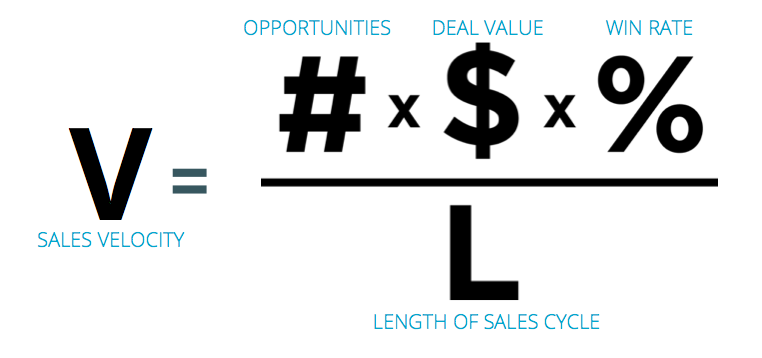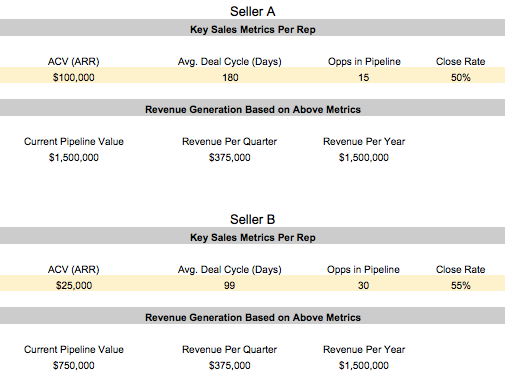One of the most enlightening and personal sales operations exercises that any rep can do is to build their own sales velocity equation.
In fact, even before sellers join a company, it can be extremely helpful to ask your prospective employer about the current sales velocity of their organization. This way, you’ll understand what kind of “sales engine” you’re about to start driving.
If they don’t have a grip on this yet (many young organizations don’t) it can be a chance to impress your prospective team with your sales-meets-operations acumen and thoughtfulness.
What is the Sales Velocity Equation?
In short, sales velocity is the calculation of four major sales ops metrics to forecast how much revenue you stand to generate over a period of time.
It comprises these four metrics:
- Average Contract Value (ACV)
- Sales cycle length
- Number of deals in your pipeline
- Win rate of deals in the pipeline
There may be different acronyms or names for the four levers depending on the organization. These are the four thematic things that affect your revenue output. The equation looks like the following:
Source: Altify
Ideally, your CRM is set up to spit out each dof these four metrics regularly in your reporting for you as an individual contributor. If it’s not, then team up with your sales ops person or take it upon yourself to start reporting on these metrics regularly.
It’ll make life way easier when the going gets tough, and you need to figure out how to get going again!
What Does The Sales Velocity Equation Look Like In Practice?
One amazing thing about this sales ops exercise is that within an organization Seller A and Seller B could generate the same amount of revenue in a given quarter (in other words, they have the same sales velocity). Yet, they may have completely different ways of getting to this outcome.
Understanding sales velocity highlights what’s different about the means to their similar end. The example below shows different inputs, yet similar results:

Enterprise versus SMB Sales Velocity
The example above is a classic scenario of an enterprise seller side-by-side with an SMB seller who both achieve the same sales velocity outcome, albeit through different approaches.
Often times in this situation, the SMB seller looks at the enterprise seller with ire, saying “If I got the chance to swing at deals as big as those deals, I’d be in amazing shape!”
On the flipside, the enterprise seller says “If only I had more deals to sell, I’d be flowing well and in great shape!”.
The two sellers are getting hung up on a constant reality when you put this equation to practice. Enterprise sellers and the pipelines that they work are always going to be fundamentally different than SMB sellers and the pipelines they work. This is part of the reason larger organizations specialize in lthe two roles.
The sales velocity components are different, and therefore the day-to-day workflow of each seller is different. But, the importance of Seller A and B to the bottom line is equal in this situation.
How to Improve Your Bottom Line: Next Steps
For starters, you can have an infinitely more thoughtful conversation with your manager.
Instead of coming to your weekly one-on-one or quarterly review saying “I’m just not hitting my number, I think you need to have an SDR pump more deals my way!”, you can dig deeper and get to the core of the problem.
A more thoughtful answer could be:
“You know, the number of deals I’m working is actually the same as last quarter, and in fact, I’m getting better at closing them. But, ever since we added this new product feature to the suite, my clients seem to get distracted and want to spend more time trying it out. The length of my sales cycles has significantly increased as a result.”
That’s just one scenario, but now we can at least focus on the right solution. You need to shorten your deal cycles, and maybe that means you need to get better at negotiating with your decision makers in this example.
1) When your ACV is plummeting, review value + ROI
2) To shorten deal cycles, get back to Negotiation 101
3) Start planning in advance if your pipeline velocity takes a hit
4) Aim for a 40%-60% close rate for a healthy pipeline
1) When your ACV is plummeting, review value + ROI
Deals that are too low in value compared to the average deal size of your company is usually the most glaring sign that your sales velocity is off.
If this is the case, some questions to consider are:
- Do I have a clear understanding of the value metrics that drive the pricing of our products upwards?
- How do I converse on those comfortably with my customer?
- Am I able to determine who the true decision makers are in a deal?
- What are the main types of ROI they care about for their businesses?
- Am I actually going after ideal customer profiles that make sense?
- Are willing to spend serious money on my company’s product?
- There are many considerations here, but these are some of the key things to think about.
2) To shorten deal cycles, get back to Negotiation 101
If your deal cycle is getting too long, this is due to a lack of negotiating power and setting expectations with your decision makers.
It can also simply be a matter of being unorganized and utilizing the wrongs tools to stay tight in your process. You can check out the best-in-class sales tools here.
3) Start planning in advance if your pipeline velocity takes a hit
This is a fairly obvious and noticeable problem too. You can feel it when things start to slow down. Be disciplined in reviewing how many opps you have in the sales pipeline, and set aside time (I like Monday afternoons) to prospect and tee up meetings for the week.
Too many opps in the pipeline usually leads to less time spent on each opportunity, and a decline in your close rate.
4) Aim for a 40%-60% close rate for a healthy pipeline
One of the most overlooked reasons for lower close rates is that you’re qualifying and letting the wrong deals into your pipeline.
Not only will this lead to your close rate dropping, but you’ll also waste precious time on the wrong deals Alternatively, sometimes your close rate can actually be too high, in my opinion. Think about all the other deals you could let into the pipeline and potentially take a shot at if you were a little less strict with who you’re qualifying into the pipeline.
You shouldn’t only add deals you feel 100% confident in closing to your pipeline. I like to aim for 40-60% close rate to maintain a healthy balance.
Make the Most of Your Sales Pipeline Velocity Equation: Dos and Don’ts
Compare personal metrics w/ team metrics
You may find that you always have more deals in your pipeline compared to your peers, but your close rate is lower.
Perhaps your friend on the team has a killer close rate, but can’t seem to get as many deals in the pipeline. Now you can trade tips together to help each other out, or you can set a plan with your manager to learn to work fewer deals, but more efficiently.
This is a real example from a past company of mine, and my friend and I used to hang out for an extra hour at the end of the day to coach each other.
Review these 4 metrics monthly and then weekly
As a second step, track these four metrics month over month for yourself, and once you feel confident in what they mean, start to track them week over week.
Put a reminder on your calendar to take 5 mins to check out last week’s performance early on Monday morning. Then you can set an intention for yourself for the week ahead to improve.
For example, if the number of opps in the pipeline are starting to dip below your personal benchmark, spend an extra two hours prospecting this week.
Discuss your sales velocity w/ your manager
Finally, take some time during each one on one with your manager to talk about where your sales velocity is at. Managers have the great privilege (and responsibility) of seeing things from 30,000 feet.
They usually know thematically how to solve most sales problem, but always need to put in an effort to identify the problem first. You can certainly help them help you (Jerry Maguire, anyone?) by identifying the true problem you’re facing.
That starts by breaking down your sales velocity and having a meaningful conversation around it. Ultimately this will increase your sales with less friction.
Sales Velocity is your new sales ops weapon!



